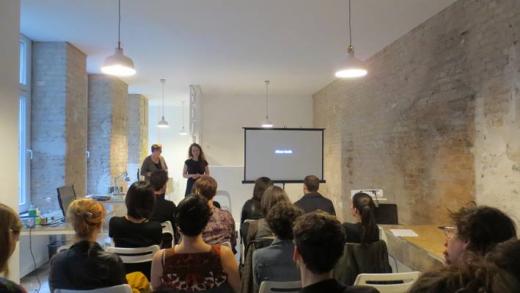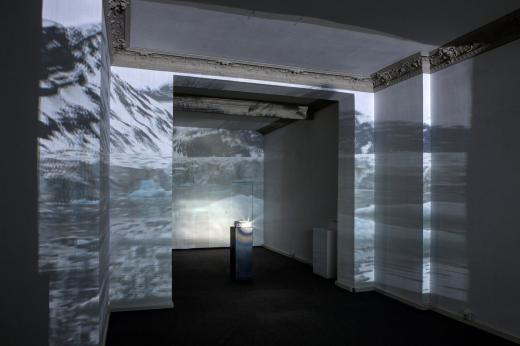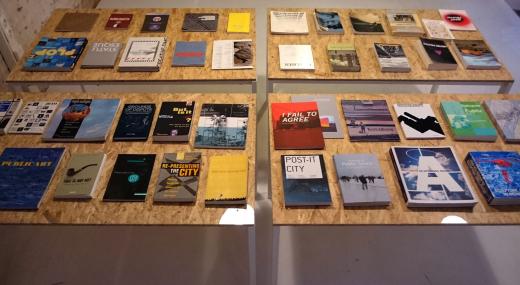Have you met... Decad
Have you met... Decad
Decad is a not-for-profit art space located in Kreuzberg, developed over the past 5 years by the artist Rachel Alliston. The project in its current form puts an emphasis on discursive roles in the productions of visual culture and social space, and works to advance an appreciation of the mutual influence of these industries.
Decad hosts an active program of artist talks and critical lectures, produces exhibitions by visiting curators, and maintains a growing research library open to interested readers. It highlights art practices based in social engagement, institutional critique and art in public space, as well as work in cultural activism, experimental architecture and community-based urbanism.
We spoke with Rachel to find out more about her project space, which she runs together with art writer Julianne Cordray and curator Ignas Petronis.
Why did you decide to initiate this project space? How did it come about?
Decad wasn’t initially intended as a fixed project space, or even as a long-term project. I started the programme in 2012, mainly as a way to gain some objective distance from what I was doing in studio while a grad student at UCL. Before there was a permanent space, there was a series of lectures, panel discussions and a couple of exhibitions, all in various academic venues and public spaces in London, which I organised under the moniker of Decad. Only after moving to Berlin in 2014 did I start thinking about opening a permanent space for the project. At that point the project became a more concerted effort and a larger team began to form around it. My friend Eva Wiedemann, an arts lawyer, offered to co-sign the lease for Decad’s current Hinterhaus space, which we opened in 2014. Up to that point, the focus was very narrowly set on art-in-public-space, and in this vein the Hinterhaus room opened in September 2014 with a group show comprising documentation - photographs and video - of works realised in public space by a range of artists and architects. They included Vito Acconci, Assemble, Rick Lowe, Cauleen Smith and Naama Tsabar among others. The photographs and videos shown there came to form the first chapter of Decad’s archive.

After that first show in Berlin closed, the Hinterhaus space started to serve as a co-working office from Monday through Friday in which PhD candidates could sublet a desk and work on their dissertations. Meanwhile I was working on building Decad’s library and archive as well as researching potential speakers for a regular lecture programme. In January 2015, the lecture programme started and has since continued in the Hinterhaus, now our lecture space. In the summer of 2015, I signed a second lease, for our current exhibition space, and there began a series of occasional presentations and events in the storefront from mid-2015 through 2016.
Juli and Ignas joined Decad in 2016, and in 2017 we started the regular exhibition programme. That officially launched in March 2017 with a show by Christopher Petit, curated by Louisa Elderton and Jelena Seng. Currently, the second exhibition is installed in the storefront, it is the work of Emilija Škarnulytė curated by Ignas Petronis. The third and fourth exhibitions will also be solo shows, one by Lou Cantor and the other by Philip Kojo Metz. Our fifth show will be curated by Lena Reisner in spring of 2018. Each show runs for ten weeks.

Emilija Škarnulytė, No Place Rising, 2017
What does the name stand for?
Decad is a unit of ten, a reference to the typical museum-model format of ten-week exhibitions which our project pursues. The name also refers to a subset of the Pythagorean writers who described the decad, the number ten, as the near-perfect number, one which could translate between the abstract and the concrete, and which was at times associated with the geometric square.
Who makes the current team of Decad? How do you each contribute to the space and the projects revolving around it?
The team is currently made up of three people: myself, an artist; Julianne Cordray, an art writer; and Ignas Petronis, a curator. We are also starting to build a board for fundraising, an initiative which is being led by Ekua Yankah and Alexandra Alexopoulou, and which is set to become an integral part of the space and project in 2018.
What is the main focus the program?
Decad’s various programmes focus on socially and critically engaged art practice.
What is the curatorial strategy at Decad? How do you develop the program and choose the artists to work with?
To begin with, five invitations have been extended to organise a show in our storefront, to a series of Berlin-based curators and artists whose work connects in very disparate ways to the socio-symbolic place of contemporary art. Petit’s show dealt with an overflow of images and pop-cultural icons in the age of the internet, viewed through the example of recently deceased David Bowie. Škarnulytė’s exhibition offers a contemporary, and intentionally literal, interpretation of the feminist cyborg in the Anthropocene; she considers the effects of humans and their technologies on the earth’s mining. Lou Cantor’s show will look to the use of technology, especially robotics and algorithms, to manipulate humans’ affective experiences. Philip Kojo Metz will present a retrospective of his project Mimicry Games, through which he makes a postcolonial critique of the culture of soccer in Europe and Africa. And Lena Reisner’s group exhibition will consider contemporary artists within a post-political ecology.

Could you introduce us to Decad's sister project – Press LMP? What can we find in your library?
Press LMP is a related though distinct project concerned with the production and distribution of art-books. Generally speaking, Press LMP issues publications that fall into three categories, by format: essay collection; monograph; and exhibition catalogue. Press LMP’s first book was released in 2015 and is a collection of essays on cultural production in public space. The second book is a catalogue edited by the curator Mareike Spendel, made in connection with a 2016 exhibition at the Neukölln project space, Centrum, which Spendel runs. The third and fourth books are currently in production. One will be a book on drawing by the artist Erica Greenwald, and the other will be a monograph written by the Berlin-based arts organiser Heiko Pfreundt.
Separately, Decad’s library is housed in the Hinterhaus lecture space. It is intended towards art historical research and is open to any interested reader by appointment. Books are primarily written in the English language and are geared towards art and society.
What was the most important lesson learned in the past years of running this space?
Always document events.
What are you currently showing at the gallery?
The exhibition Manifold by Emilija Škarnulytė, curated by Ignas Petronis, runs through 26 August 2017. Within Decad’s lecture programme, Škarnulytė will speak on her work on the evening of Wednesday, 9 August, in the Hinterhaus.
What is coming next?
The next exhibition will be one by Lou Cantor, opening in September 2017.
* * * * *
DECAD
Gneisenaustrasse 52, 10961 Berlin
www.decad.org
Current exhibition:
Emilija Škarnulytė – “Manifold”
Ongoing until August 26, 2017
More info
Coming up:
Emilija Škarnulytė – Artist Talk with Timothy Morton
August 9, 2017; 19h
More info